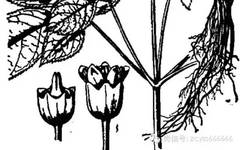Herb Name: Ginseng (Ren Shen), Lin Xia Shen, Zi Hai
Alias: Sheng Shai Shan Shen, Yi Shan Shen
Harvesting and Processing: Harvested mainly in autumn, cleaned; freeze-dried ginseng is known as “active ginseng”
Medicinal Part: Root
Origin: Northeastern moving mountain ginseng
Family: Araliaceae
Original Plant: Ginseng
Plant Description: Perennial herbaceous plant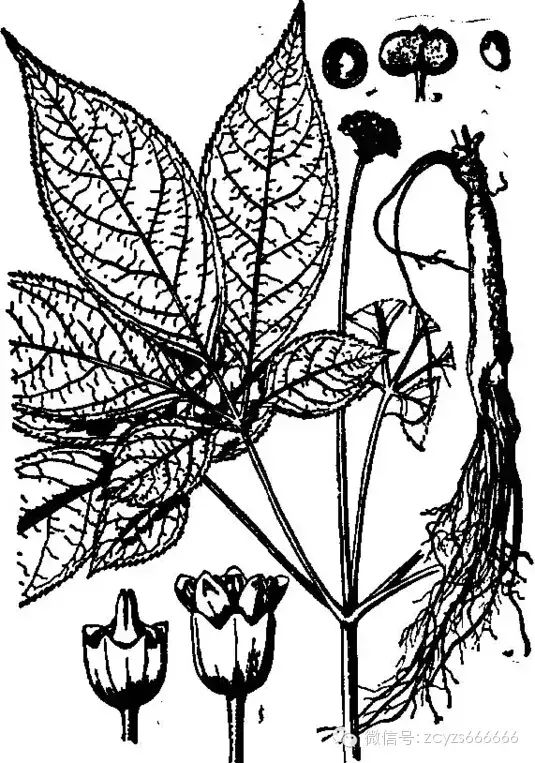 Height 30-60 cm. The main root is thick, fleshy, yellowish-white, cylindrical or spindle-shaped, with slight branching below; the rhizome (lu tou) is short and upright. The stem is upright, cylindrical, and unbranched.
Height 30-60 cm. The main root is thick, fleshy, yellowish-white, cylindrical or spindle-shaped, with slight branching below; the rhizome (lu tou) is short and upright. The stem is upright, cylindrical, and unbranched.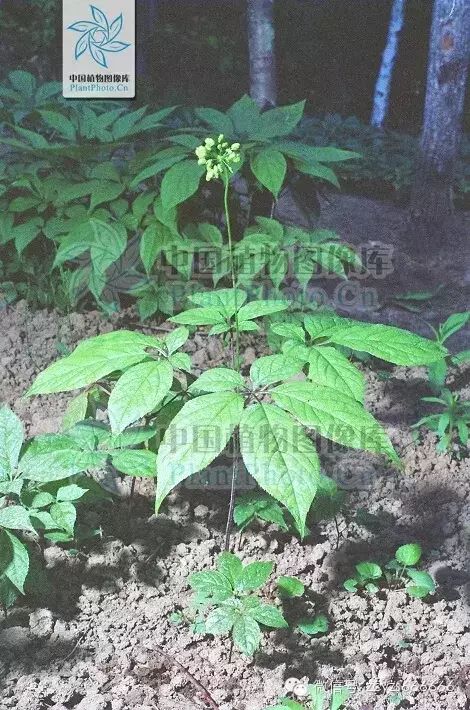 One-year-old plants have only one leaf at the top, with three leaflets, commonly known as “San Hua”; two-year-old stems still have one leaf but with five leaflets, called “Ba Zhang”; three-year-olds have two pairs of five-leaf compound leaves, called “Er Jia Zi”; four-year-olds increase to three whorled compound leaves, called “Deng Tai Zi”; five-year-olds have four whorled compound leaves, called “Si Pi Ye”; six-year-olds have five whorled compound leaves, called “Wu Pi Ye”; the compound leaves are palmate, with 3-5 leaflets, the middle three are nearly equal in size, with small petioles; the leaflets are oval or slightly obovate, 4-15 cm long, 2-6.5 cm wide, tapering to a point at the tip, wedge-shaped at the base, with finely serrated edges, sparsely covered with fine hairs on the upper veins, and hairless underneath, with the lowest pair of leaflets being very small and without petioles.
One-year-old plants have only one leaf at the top, with three leaflets, commonly known as “San Hua”; two-year-old stems still have one leaf but with five leaflets, called “Ba Zhang”; three-year-olds have two pairs of five-leaf compound leaves, called “Er Jia Zi”; four-year-olds increase to three whorled compound leaves, called “Deng Tai Zi”; five-year-olds have four whorled compound leaves, called “Si Pi Ye”; six-year-olds have five whorled compound leaves, called “Wu Pi Ye”; the compound leaves are palmate, with 3-5 leaflets, the middle three are nearly equal in size, with small petioles; the leaflets are oval or slightly obovate, 4-15 cm long, 2-6.5 cm wide, tapering to a point at the tip, wedge-shaped at the base, with finely serrated edges, sparsely covered with fine hairs on the upper veins, and hairless underneath, with the lowest pair of leaflets being very small and without petioles.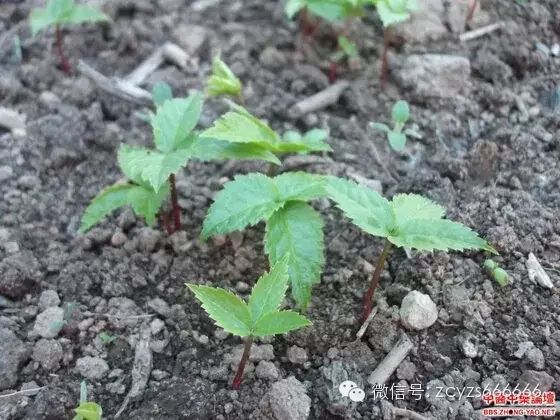
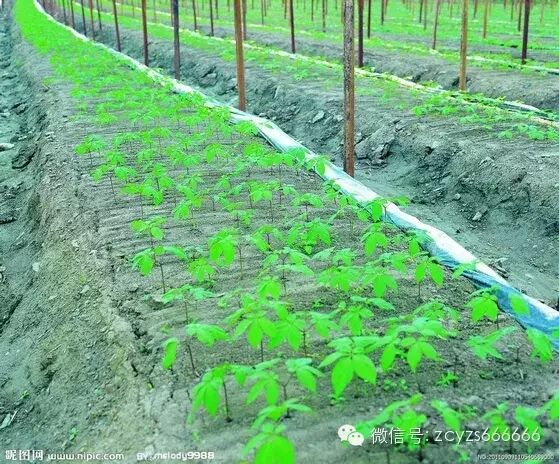

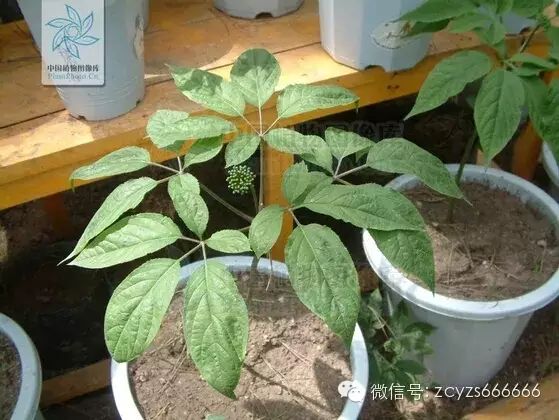 Flowers bloom in summer, with a single umbel at the top of the leaf cluster, the total flower stalk can reach 30 cm, with each umbel containing 4-40 flowers, and the flower stalks are about 5 mm long. The bracts are small and lanceolate; the calyx is bell-shaped, fused with the ovary, with 5 lobes, green; the petals are 5, oval, entire, pale yellow-green; there are 5 stamens with short filaments; 1 pistil, with a lower ovary, 2 chambers, and 2 styles, the upper parts separate and the lower parts fused.
Flowers bloom in summer, with a single umbel at the top of the leaf cluster, the total flower stalk can reach 30 cm, with each umbel containing 4-40 flowers, and the flower stalks are about 5 mm long. The bracts are small and lanceolate; the calyx is bell-shaped, fused with the ovary, with 5 lobes, green; the petals are 5, oval, entire, pale yellow-green; there are 5 stamens with short filaments; 1 pistil, with a lower ovary, 2 chambers, and 2 styles, the upper parts separate and the lower parts fused.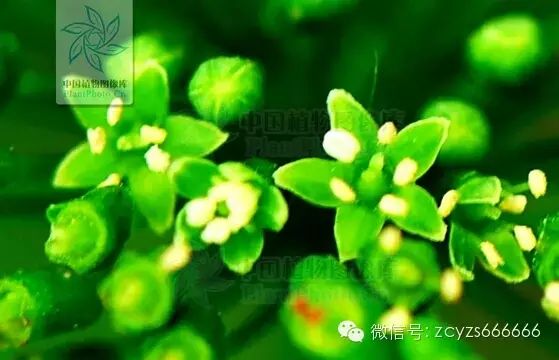 The berries are flat and round, turning bright red when ripe, containing two semi-circular seeds.
The berries are flat and round, turning bright red when ripe, containing two semi-circular seeds.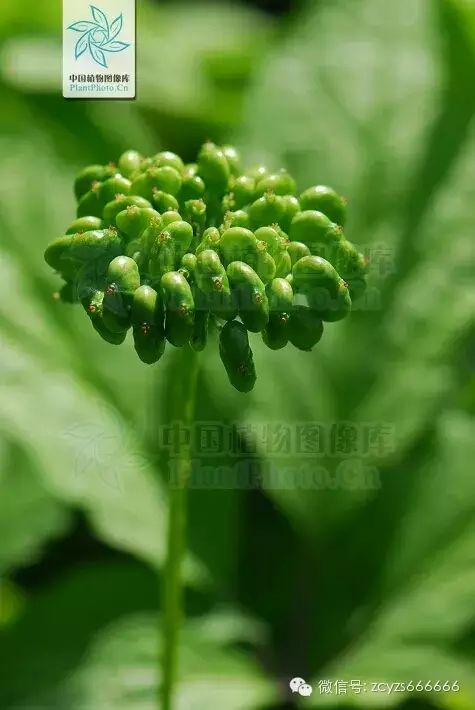
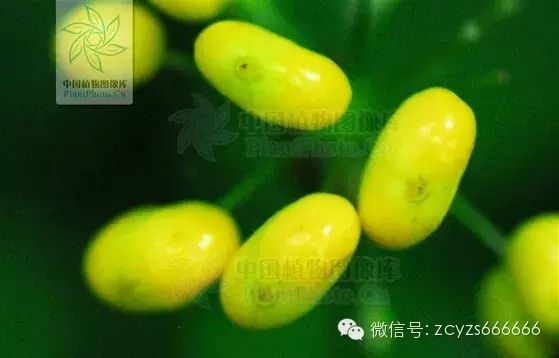 Ginseng (Ren Shen), Lin Xia Shen, Zi Hai medicinal properties:
Ginseng (Ren Shen), Lin Xia Shen, Zi Hai medicinal properties:
【Shennong’s Classic of Materia Medica】 Ginseng has a sweet and slightly cold taste. It primarily tonifies the five organs, calms the spirit, stabilizes the soul, stops palpitations, expels evil qi, brightens the eyes, and enhances intelligence. Long-term use promotes longevity and lightness of body. It is known as “Ren Xian” and “Gui Gai”.
It has a sweet and slightly bitter taste, entering the Foot Yangming Stomach and Foot Taiyin Spleen meridians. It enters the Earth element and benefits Stomach qi, moves through the Earth element to assist Spleen yang, regulates the center, quenches thirst, and is a vital medicine for long-term benefits, especially in hot summer when it can restore qi.
Qi is abundant in the lungs and originates from the kidneys; lung qi descends and transforms kidney water; water is not qi, but water contains lung qi (this qi in water is referred to as the source of life in the “Nanjing”, and in Daoism, it is called the qi in water). This is the principle of yin and yang, where they mutually root each other; yin rises and transforms into yang, while also containing yin essence; yang descends and transforms into yin, while also nurturing yang qi. When yang qi is generated, the Earth element rotates leftward, rising in the southeast, transforming into wood and fire. The spleen, being yin in nature, embraces the yang spirit; if spleen yang does not sprout in spring, wood will not warm; if spleen yang does not grow in summer, fire will not be hot. Therefore, although the liver and spleen are abundant in blood, the warmth in the blood is actually the source of yang rising and transforming into fire. When it rises to fire and descends to metal, qi is abundant. Thus, if the liver and spleen qi is deficient, lung and stomach qi is abundant. Deficiency and abundance lead to the liver and spleen rising, while abundance and deficiency lead to lung and stomach descending. Abundance and abundance lead to stomach obstruction and non-descending, while deficiency and deficiency lead to liver and spleen depression and non-rising, all due to the weakness of central qi. Central qi resides between the Earth and the Earth, neither metal nor wood; when it is strong, the deficient is filled and rises leftward, while the abundant pushes the deficient and descends rightward, with neither excess on the right nor deficiency on the left. If central qi is not strong, the wheel cannot turn; the deficient becomes more deficient and sinks leftward, while the abundant becomes more abundant and reverses rightward.
Cooked ginseng is warm and moist, while raw ginseng is clear and moist.
Harvest the roots, scrape with a bamboo knife, dry in the sun, and avoid exposure to wind. Ginseng with a human shape can cause children to cry.
【Origin】 The best quality comes from Jilin and Liaoning in China, with production also in Changzi County, Shanxi, Yao’an County, Yunnan, and Shucheng County, Anhui, as well as abundant production in Korea.
【Properties and Taste】 Sweet, slightly bitter, slightly cold, non-toxic.
【Indications】 Ginseng is a major tonic for original qi, effective for all forms of weakness and consumption, circulating qi throughout the body and tonifying the five organs, with a slow but effective action. The red variety is known as Korean ginseng, which is warm and more potent.
【Indications】 It is used for the five labors and seven injuries, weakness and atrophy, stopping vomiting, tonifying the five organs and six bowels, preserving the center and guarding the spirit. It resolves phlegm in the chest, treats lung atrophy and epilepsy, counteracts cold qi rising, and is effective for febrile diseases with food not descending; it can be used for all forms of deficiency and excessive dreaming.
【Elements】 It treats insufficient lung and stomach yang qi, lung qi deficiency leading to shortness of breath, tonifying the center and alleviating symptoms. It drains heart, lung, spleen, and stomach fire evil, stops thirst, and generates fluids.
【Usage】 Ginseng is often used for patients recovering from illness, combined with other herbs for regulation; it is used to assist other herbs in treatment, and nowadays, ginseng is mostly cultivated artificially, with less potency than wild ginseng. We can use Huang Qi (Astragalus) and Gan Cao (Licorice) as substitutes for ginseng, and in formulas, Dang Shen (Codonopsis) is often used instead of ginseng.
Due to its growth in damp, shady areas, it absorbs the moistening energy of water, hence its bitter and sweet taste and juicy nature, producing three-leaf and five-leaf forms, which are yang in number; it grows in the shade and emerges as yang, thus having a unique yang energy within its sweet and bitter taste. The original qi of the human body rises from kidney water to the lungs, which also follows the principle of growing in the shade and emerging as yang, similar to ginseng, thus ginseng is very effective in transforming qi, and when qi transforms and rises, it emerges from the mouth and nose, which is the essence of fluids, hence ginseng can generate fluids. Ginseng grows in the north and is known as a medicine of yin with yang properties, effective in transforming qi and tonifying fluids. 【Processing】 Wrap in a damp cloth, steam, then dry or bake.
【Indications】 It is indicated for a feeling of fullness and hardness in the chest, phlegm accumulation, and is also effective for loss of appetite, vomiting, excessive salivation, heart pain, abdominal pain, and palpitations.
【Spirit and Essence】 It raises original qi and tonifies the five organs, having the function of promoting righteousness and expelling evil, but should not be taken by those who are not deficient.
【Dosage】 Generally 5-9 grams, or 1-2 taels for large doses.
【Contraindications】 It is contraindicated for symptoms of heat in the lungs and yin deficiency with fire, as well as in the early stages of measles, where the body is hot but spots have not yet formed, and in the early stages of febrile diseases where symptoms are not yet defined and evil heat is intense, and should not be used with Li Lu (Veratrum).
Processing: Raw ginseng: moisten, slice thinly, and dry.
White sugar ginseng: scalded with water, soaked in sugar, then dried.
Red ginseng: steamed and then dried or baked.
【Properties and Taste】 Sweet, slightly bitter, neutral.
【Meridian Entry】 Enters the Spleen, Lung, and Heart meridians.
【Functions and Indications】 Greatly tonifies original qi, restores pulse, stabilizes collapse, tonifies spleen and benefits lungs, generates fluids, and calms the spirit. It is used for body weakness and impending collapse, cold limbs and weak pulse, spleen deficiency with poor appetite, lung deficiency with cough and wheezing, fluid damage with thirst, internal heat with thirst, prolonged illness with weakness, palpitations and insomnia, impotence, and cold in the palace; heart failure and cardiogenic shock.
【Usage and Dosage】 3-9 grams, decocted separately and added to soups; wild mountain ginseng can be powdered and taken, 2 grams at a time, twice a day.
【Caution】 Not suitable for use with Li Lu.
【Storage】 Store in a cool, dry place, sealed to prevent pests.

